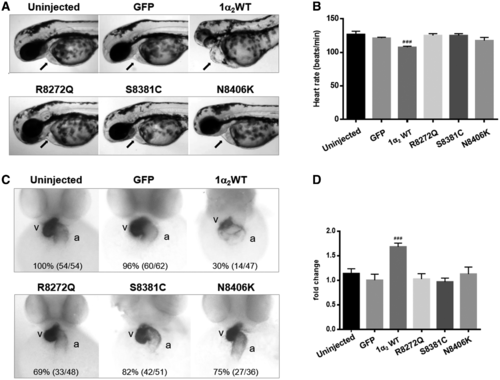- Title
-
Novel nesprin-1 mutations associated with dilated cardiomyopathy cause nuclear envelope disruption and defects in myogenesis
- Authors
- Zhou, C., Li, C., Zhou, B., Sun, H., Koullourou, V., Holt, I., Puckelwartz, M.J., Warren, D.T., Hayward, R., Lin, Z., Zhang, L., Morris, G.E., McNally, E.M., Shackleton, S., Rao, L., Shanahan, C.M., Zhang, Q.
- Source
- Full text @ Hum. Mol. Genet.
|
Human nesprin-1α2 WT induces heart development defects in zebrafish. Lateral views of zebrafish live embryos at 48 hpf. The pericardium (A, arrowed) and heart rate are shown for each corresponding mRNA injected (B), zebrafish embryos with nesprin1α2 WT mRNA showed slow heart rate and dilated atrial chambers. Whole-mount in situ hybridization (WISH) monitoring expression of the myl7 gene at 48 hpf (C), the numbers (left in brackets) indicate the percentage of embryos displaying the phenotype represented in the picture shown, the numbers (right in brackets) is the total numbers counted of observed embryos. The relative atrium area of embryos for the corresponding mRNA injection was measured and calculated by the area of myl7 expression using ImageJ (D), which was normalised to the atrium area of the embryos injected with GFP mRNA. Embryos are in ventral views with the anterior at the top. About 4–7 embryos for each injection were measured. Means and SEM were obtained from three independent experiments for each treatment. P < 0.001 using Student’s t-tests. a: atrium, v: ventricle. |
|
Human nesprin-1a2 WT induced heart development defects while mutants induce a less severe heart phenotype in zebrafish embryos . WISH monitoring expression of the myl7 gene at 48 hpf (A), the numbers (left in brackets) indicate the percentage of embryos displaying the phenotype represented in the picture shown, the numbers (right in brackets) are the total numbers counted of observed embryos. Human nesprin-1α2 WT caused a dilated heart phenotype (B-D), and both WT and mutants caused defects in heart looping when compared with uninjected shown (A,B) and abnormal anterior-posterior axis development (C, D) in the injected embryos when compared with uninjected and GFP expressing embryos. Approximately 36 to 62 embryos for each injection were counted; the representative picture (D) shows abnormal anterior-posterior axis development (black arrowhead) and dilated heart (red arrow) for the affected embryos. |


